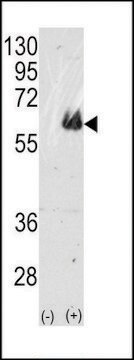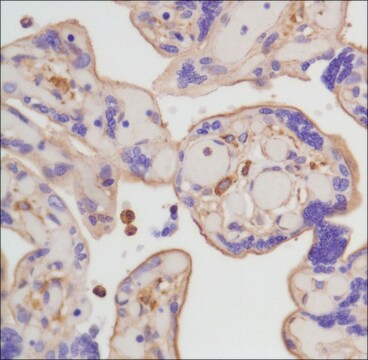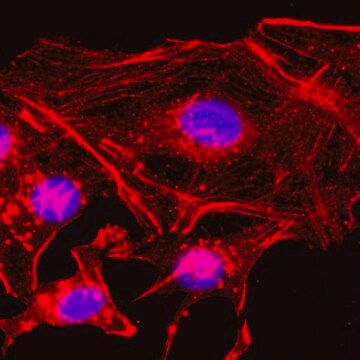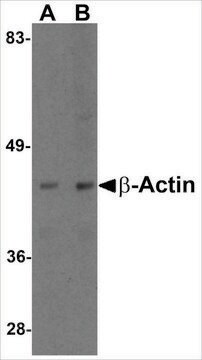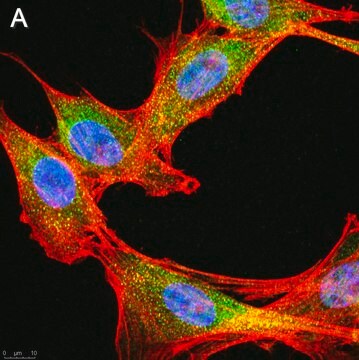일반 설명
We are committed to bringing you greener alternative products, which adhere to one or more of The 12 Principles of Green Chemistry.This antibody is Preservative-free, produced without the harm or sacrifice of animals and exceptionally stable to allow for ambient shipping and storage if needed and thus aligns with "Waste Prevention", "Designing Safer Chemicals" and "Design for Energy Efficiency".
Click here for more information.
ZooMAb® antibodies represent an entirely new generation of recombinant monoclonal antibodies.Each ZooMAb® antibody is manufactured using our proprietary recombinant expression system, purified to homogeneity, and precisely dispensed to produce robust and highly reproducible lot-to-lot consistency. Only top-performing clones are released for use by researchers. Each antibody is validated for high specificity and affinity across multiple applications, including its most commonly used application. ZooMAb® antibodies are reliably available and ready to ship when you need them.
특이성
Clone 1F9 is a ZooMAb® rabbit recombinant monoclonal antibody that specifically detects human Serine/threonine-protein kinase/endoribonuclease IRE1 (IRE-1 ). It targets an epitope within 21 amino acids from the C-terminal region.
면역원
KLH-conjugated linear peptide corresponding to 21 amino acids from the C-terminal region of human Serine/threonine-protein kinase/endoribonuclease IRE1 (IRE-1 ).
애플리케이션
Quality Control Testing
Evaluated by Western Blotting in HepG2 cell lysate.
Western Blotting Analysis: A 1:1,000 dilution of this antibody detected IRE1 in HepG2 cell lysate.
Tested applications
Western Blotting Analysis: A 1:1,000 dilution from a representative lot detected IRE1 in HEK293 cell lysate.
Immunocytochemistry Analysis: A 1:1,000 dilution from a representative lot detected IRE1 in HepG2 cells.
Affinity Binding Assay: A representative lot of this antibody bound IRE1 peptide with a KD of 5.2 x 10-8 in an affinity binding assay.
Immunohistochemistry (Paraffin) Analysis: A 1:1,000 dilution from a representative lot detected IRE1 in human tonsil tissue sections.
Note: Actual optimal working dilutions must be determined by end user as specimens, and experimental conditions may vary with the end user
Evaluated by Western Blotting in HepG2 cell lysate.
Western Blotting Analysis: A 1:1,000 dilution of this antibody detected IRE1 in HepG2 cell lysate.
표적 설명
Serine/threonine-protein kinase/endoribonuclease IRE1 (UniProt: O75460; also known as Endoplasmic reticulum-to-nucleus signaling 1, Inositol-requiring protein 1, hIRE1p, Ire1-alpha, IRE1 ) is encoded by the ERN1 (also known a IRE1) gene (Gene ID: 2081) in human. IRE1 is a single-pass type I membrane protein that is synthesized with a signal peptide (aa 1-18), which is subsequently cleaved off to generate the mature form that contains a lumenal domain (aa 19-443), a transmembrane domain (aa 444-464), and a long cytoplasmic domain (aa 465-977). It serves as a serine/threonine-protein kinase and endoribonuclease that acts as a key sensor for the endoplasmic reticulum unfolded protein response (UPR). IRE1 activity can induce both protective UPR and apoptotic downstream signaling events. In unstressed cells, the endoplasmic reticulum luminal domain is maintained in its inactive monomeric state by binding to the endoplasmic reticulum chaperone HSPA5/BiP. Accumulation of misfolded proteins in the endoplasmic reticulum causes release of HSPA5/BiP, which allows the luminal domain to homodimerize and promote autophosphorylation of the kinase domain and subsequent activation of its endoribonuclease activity. Its endoribonuclease activity is shown to be specific for XBP1 mRNA and excises 26 nucleotides from XBP1 mRNA. The resulting spliced transcript of XBP1 encodes a transcriptional activator protein that up-regulates expression of UPR target genes. IRE1 is shown to induce transient ER stress signaling and confer a protective effect against pressure overload-induced pathological remodeling in the murine heart. This ZooMAbZooMAb® recombinant monoclonal antibody, generated by our propriety technology, offers significantly enhanced specificity, affinity, reproducibility, and stability over conventional monoclonals. (Ref.: Steiger, D., et al (2018). J. Biol. Chem. 293(25); 9652-9661; Ali, MMU., et al. (2011); EMBO J. 30(5); 894-905; Liu, Cy., et al. (2003). J. Biol. Chem. 278(20); 17680-17680).
물리적 형태
Purified recombinant rabbit monoclonal antibody IgG, lyophilized in PBS, 5% Trehalose, normal appearance a coarse or translucent resin. The PBS/trehalose components in the ZooMAb formulation can have the appearance of a semi-solid (bead like gel) after lyophilization. This is a normal phenomenon. Please follow the recommended reconstitution procedure in the data sheet to dissolve the semi-solid, bead-like, gel-appearing material. The resulting antibody solution is completely stable and functional as proven by full functional testing. Contains no biocide or preservatives, such as azide, or any animal by-products. Larger pack sizes provided as multiples of 25 μL.
재구성
300 μg/mL after reconstitution at 25 μL per vial. Please refer to guidance on suggested starting dilutions and/or titers per application and sample type.
저장 및 안정성
Recommend storage of lyophilized product at 2-8°C; Before reconstitution, micro-centrifuge vials briefly to spin down material to bottom of the vial; Reconstitute each vial by adding 25 μL of filtered lab grade water or PBS; Reconstituted antibodies can be stored at 2-8°C, or -20°C for long term storage. Avoid repeated freeze-thaws.
법적 정보
ZooMAb is a registered trademark of Merck KGaA, Darmstadt, Germany
면책조항
Unless otherwise stated in our catalog or other company documentation accompanying the product(s), our products are intended for research use only and are not to be used for any other purpose, which includes but is not limited to, unauthorized commercial uses, in vitro diagnostic uses, ex vivo or in vivo therapeutic uses or any type of consumption or application to humans or animals.

